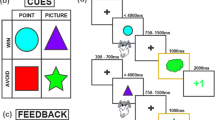Abstract
Three experiments are reported that bridge previous research on evaluative learning and attentional bias for emotional material. Research in the latter area has shown that negatively valenced stimuli selectively capture attention in those prone to anxiety or depression. It remains unclear whether this is due to differences in acquired emotional evaluations or different attentional responses to similarly evaluated stimuli. We first replicated earlier findings that pictures paired with unpleasant images are disliked more than those associated with pleasant images. However, these effects on liking did not vary with differences in negative emotionality (neuroticism). In two further experiments, despite the consistent absence of individual difference effects on subjective liking, pictures associated with negative images selected by participants caused more attentional interference in high-neuroticism participants. For low-neuroticism participants, pictures previously paired with pleasant images tended to cause greater interference. Thus, with prior evaluative learning controlled, individuals varying in neuroticism still differ in their attention to newly emotionalized stimuli.
Similar content being viewed by others
REFERENCES
Baeyens, F., Eelen, P., Crombez, G., & Van den Bergh, O. (1992). Human style and contingency awareness. Behaviour Research and Therapy, 30, 133–142.
De Houwer, J., Baeyens, F., & Eelen, P. (1994). Verbal evaluative conditioning with undetected US presentation. Behaviour Research and Therapy, 32, 629–633.
Eysenck, H. J., & Eysenck, S. B. G. (1991). Manual of the Eysenck Personality Questionnaires-EPQRevised. London: Hodder & Stoughton.
Fulcher, E. P. (1993). The construction of evaluative maps in classical and operant conditioning. Unpublished Ph.D. thesis, University of London.
Fulcher, E. P., & Cocks, R. P. (1997). Dissociative storage systems in human evaluative conditioning. Behaviour Research and Therapy, 35, 1–10.
Hill, T., Lewicki, P., & Neubauer, R. M. (1991). The development of depressive encoding dispositions: A case of self-perpetuation of biases. Journal of Experimental Social Psychology, 27, 392–409.
LeDoux, J. (1996). The emotional brain. New York: Simon & Schuster.
Levey, A. B., & Martin, I. (1975). Classical conditioning of human “evaluative” responses. Behaviour Research and Therapy, 13, 221–226.
MacLeod, C., Mathews, A., & Tata, P. (1986). Attentional bias in emotional disorders. Journal of Abnormal Psychology, 95, 15–20.
Mathews, A., & Mackintosh, B. (1998). A cognitive model of selective processing in anxiety. Cognitive Therapy and Research, 22,539–560.
Mathews, A., Mackintosh, B., & Fulcher, E. P. (1997). Cognitive biases in anxiety and attention to threat. Trends in Cognitive Sciences, 1, 340–345.
Mathews, A., & MacLeod, C. (1994). Cognitive approaches to emotion and emotional disorders. Annual Review of Psychology, 45, 25–50.
Mathews, A., Ridgeway, V., & Williamson, D. A. (1996). Evidence for attention to threatening stimuli in depression. Behaviour Research and Therapy, 34, 695–705.
Posner, M. I. (1980). Orienting of attention. Quarterly Journal of Experimental Psychology, 32,3–25.
Seamon, J. G., Marsh, R. L., & Brody, N. (1984). Critical importance of exposure duration for affective discrimination of stimuli that are not recognized. Journal of Experimental Psychology: Learning, Memory and Cognition, 10, 465–469.
Stormark, K. M., & Hugdahl, K. (1996). Peripheral cueing of covert spatial attention before and after emotional conditioning of the cue. International Journal of Neuroscience, 86, 225–240.
Williams, J. M. G., Mathews, A., & MacLeod, C. (1996). The emotional Stroop task and psychopathology. Psychological Bulletin, 120, 3–24.
Williams, J. M., Watts, F. N., MacLeod, C., & Mathews, A. (1997). Cognitive psychology and emotional disorders (2nd ed.) Chichester, UK: Wiley.
Zajonc, R. B. (1980). Feeling and thinking: Preferences need no inferences. American Psychologist, 35, 151–75.
Author information
Authors and Affiliations
Rights and permissions
About this article
Cite this article
Fulcher, E.P., Mathews, A., Mackintosh, B. et al. Evaluative Learning and the Allocation of Attention to Emotional Stimuli. Cognitive Therapy and Research 25, 261–280 (2001). https://doi.org/10.1023/A:1010732328104
Issue Date:
DOI: https://doi.org/10.1023/A:1010732328104



